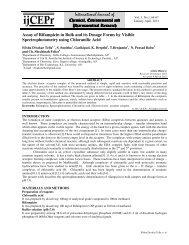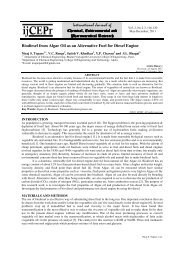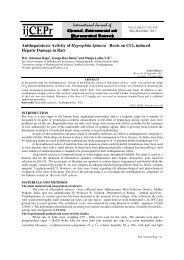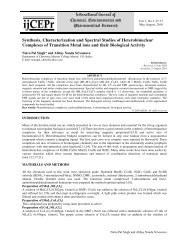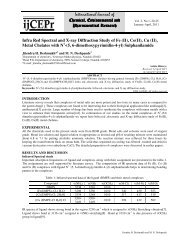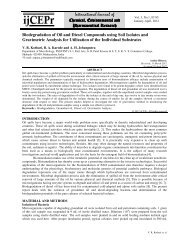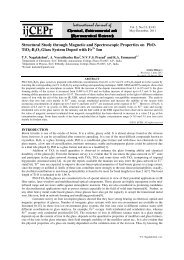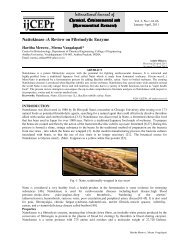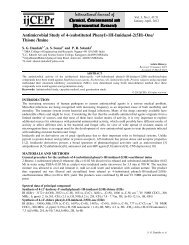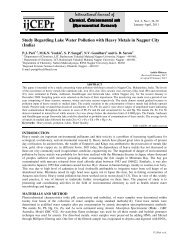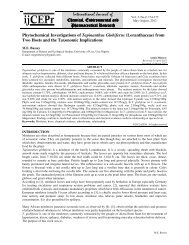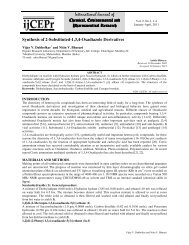Production of Protease from Sesame Oil Cake by Penicillium ...
Production of Protease from Sesame Oil Cake by Penicillium ...
Production of Protease from Sesame Oil Cake by Penicillium ...
Create successful ePaper yourself
Turn your PDF publications into a flip-book with our unique Google optimized e-Paper software.
International Journal <strong>of</strong><br />
Chemical, Environmental and<br />
Pharmaceutical Research<br />
Vol. 3, No.2, 137-141<br />
May-August, 2012<br />
<strong>Production</strong> <strong>of</strong> <strong>Protease</strong> <strong>from</strong> <strong>Sesame</strong> <strong>Oil</strong> <strong>Cake</strong> <strong>by</strong> <strong>Penicillium</strong> Chrysogenum<br />
under Solid State Fermentation<br />
B. Nagamani, M.V.V Chandana Lakshmi * , V. Sridevi and P. Rajani<br />
Centre for Biotechnology, Department <strong>of</strong> Chemical Engineering, Andhra University,<br />
Visakhapatnam-03, Andhra Pradesh, India.<br />
*E-mail: mahantilakshmi@yahoo.com<br />
Article History:<br />
Received: 13 April 2012<br />
Accepted: 15 August 2012<br />
ABSTRACT<br />
The present work describes the biosynthesis <strong>of</strong> neutral protease <strong>by</strong> <strong>Penicillium</strong> chrysogenum (NCIM 737) through solid state<br />
fermentation. Environmental parameters such as fermentation time, fermentation temperature and pH were optimized for the<br />
production <strong>of</strong> protease. It was found that the maximum production <strong>of</strong> neutral protease <strong>by</strong> the mold culture was obtained for 7<br />
days <strong>of</strong> fermentation, Similarly, pH <strong>of</strong> 7.0 and incubation temperature <strong>of</strong> 25 0 C.<br />
Keywords: Solid state fermentation, sesame oil cake, <strong>Penicillium</strong> chrysogenum NCIM 737, Neutral protease, fermentation time,<br />
temperature, pH.<br />
©2012 ijCEPr. All rights reserved<br />
INTRODUCTION<br />
<strong>Protease</strong>s are the degradative enzymes, which catalyze the total hydrolysis <strong>of</strong> proteins. The total molecular weight <strong>of</strong><br />
proteases ranges <strong>from</strong> 18-90 kDA[1]. <strong>Protease</strong>s are the most important industrial enzymes accounting for about 60%<br />
<strong>of</strong> the total enzyme market [2,3]. According to Enzyme Commission (EC) classification, proteases belong to group 3<br />
(hydrolases), and subgroup 4 (which hydrolyse peptide bond) [4]. Commercial application <strong>of</strong> microbial proteases is<br />
attractive due to the relative ease <strong>of</strong> large scale production as compared to proteases <strong>from</strong> plants and animals [5].<br />
Molds <strong>of</strong> the genera Aspergillus, <strong>Penicillium</strong> and Rhizopus are especially useful for producing proteases, as several<br />
species <strong>of</strong> these genera are generally regarded as safe [6]. Microbial proteases account for approximately 40% <strong>of</strong> the<br />
total worldwide enzyme sales, since they possess almost all the characteristics desired for biotechnological<br />
applications [7,8].<br />
Among microbes, fungi as enzyme producers have many advantages, since they are normally GRAS (generally<br />
regarded as safe) strains and the produced enzymes are extra cellular which makes its easy recuperation <strong>from</strong><br />
fermentation broth [9].The major uses <strong>of</strong> free proteases occur in dry cleaning, detergents, meat processing, cheese<br />
making, silver recovery <strong>from</strong> photographic film, production <strong>of</strong> digestive and certain medical treatments <strong>of</strong><br />
inflammation and virulent wounds [10].<br />
<strong>Protease</strong>s are mainly classified on the basis <strong>of</strong> their pH optimum as acidic, neutral or alkaline proteases [11]. Neutral<br />
proteases are mainly used in food processing such as baking, brewing, and also in the healthcare sector. One <strong>of</strong> the<br />
more recent applications <strong>of</strong> these proteases exploit their eco-friendly nature and hence their suitability to act as food<br />
processing aids, wherein these enzymes can be used for the extraction <strong>of</strong> plant oils [11,12].<br />
<strong>Protease</strong>s are extra cellular enzymes that can be produced <strong>by</strong> both submerged fermentation and solid state<br />
fermentation [6] (SSF). SSF <strong>of</strong>fers the greatest possibilities when fungi are used. Because, unlike other<br />
microorganisms, these typically grow in solid substrates [13]. Some <strong>of</strong> the advantages <strong>of</strong> SSF over conventional<br />
submerged cultures for work involving fungi are: (a) simplicity <strong>of</strong> equipment, (b)low moisture content, which<br />
prevents bacterial contamination, (c)superior volumetric productivity, (d)use <strong>of</strong> inexpensive substrates, (d)simpler<br />
downstream processing, (e)lower energy requirement and flow wastewater output [13,14].<br />
The present study was undertaken to produce the neutral protease under SSF <strong>by</strong> P. chrysogenum<br />
NCIM 737 using sesame oil cake as substrate, and to determine the optimum value <strong>of</strong> fermentation time,<br />
temperature and pH for maximum production <strong>of</strong> protease.<br />
MATERIALS AND METHODS<br />
Substrate<br />
The substrates used in this study namely Green gram husk, Black gram husk, Rice bran, Coconut oil cake, <strong>Sesame</strong><br />
oil cake (SOC) and Paddy straw + Rice bran (7:3) were obtained <strong>from</strong> local grocery shop in Visakhapatnam.<br />
B. Nagamani et. al
Vol.3, No.2, 137-141 (2012)<br />
Microorganism and maintenance <strong>of</strong> culture<br />
The organism used in the present study, P. chrysogenum NCIM 737 which was obtained <strong>from</strong> National Collection <strong>of</strong><br />
Industrial Microorganisms (NCIM), Pune, India. The culture was routinely maintained on potato dextrose agar<br />
slants. The organism was subcultured for every month.<br />
Inoculum preparation<br />
The inoculum was prepared <strong>by</strong> dispersing the spores <strong>from</strong> a week-old fungal slant culture in 0.1 % Tween-80<br />
solution with a sterile inoculation loop.<br />
Solid-State fermentation<br />
Five grams <strong>of</strong> substrate was taken in 250 ml Erlenmeyer flask separately, moistened with salt solution [composition<br />
(%w/v) (g/100ml): ammonium nitrate 0.5, potassium dihydrogen orthophosphate 0.2, sodium chloride 0.1 and<br />
magnesium sulfate 0.1], sterilized at 121.5ºC for 15 min, cooled inoculated with 1 ml <strong>of</strong> fungal spore suspension and<br />
incubated at 25ºC for 7 days.<br />
Extraction <strong>of</strong> crude enzyme<br />
A solution <strong>of</strong> Tween 80 (0.1%) was added in 100 ml <strong>of</strong> distilled water. 25 ml <strong>of</strong> water was added to the 5 gm <strong>of</strong><br />
fermented substrate and the substrate was homogenized on a rotary shaker at 180 rpm for 1 hr and then filtered the<br />
solution. The solids were removed <strong>by</strong> centrifuging the homogenate at 8000 x g at 4ºC for 15 min and the resultant<br />
clear supernatant was used for analytical studies.<br />
Assay for neutral protease<br />
To 200 µL <strong>of</strong> crude enzyme extract, 500 µL <strong>of</strong> casein (1%) and 300 µL <strong>of</strong> 0.2 mol/L phosphate buffer (pH 7.0) were<br />
added. The reaction mixture was incubated at 60°C for 10 min and arrested <strong>by</strong> the addition <strong>of</strong> 1mL <strong>of</strong> 10% trichloro<br />
acetic acid [16]. The reaction mixture was centrifuged at 8000 x g at 4 0 C for 15 min and to the supernatant, 5 mL <strong>of</strong><br />
0.4 mol/L Na 2 CO 3 , 1 mL <strong>of</strong> 3-fold diluted Folin and Ciocalteau’s phenol reagent were added. The resulting solution<br />
was incubated at room temperature for 30 min and the absorbance <strong>of</strong> the blue color developed was read at 660 nm<br />
and its concentration was determined using tyrosine standard curve. One unit <strong>of</strong> enzyme activity was defined as the<br />
amount <strong>of</strong> enzyme that liberated one microgram <strong>of</strong> tyrosine <strong>from</strong> substrate (casein) per minute under assay<br />
conditions.<br />
Standard graph for tyrosine<br />
To a series <strong>of</strong> test tubes, 0.1mL, 0.2mL, 0.4mL, 0.6mL, 0.8mL, 1mL <strong>of</strong> standard solution <strong>of</strong> tyrosine (100 µg/mL)<br />
was taken and water is added to each test tube to make the solution up to 1mL. Each test tube contains 10, 20, 40,<br />
60, 80, 100 µg/mL <strong>of</strong> tyrosine. To each test tube 5 mL <strong>of</strong> 0.5 M Na 2 CO 3 and 1 mL <strong>of</strong> 3-fold diluted Folin and<br />
Ciocalteau’s Phenol reagent were added and incubated for 30 min. The optical density <strong>of</strong> above solutions was<br />
measured at 660 nm (Fig. 1). Blank was prepared with 1mL <strong>of</strong> water instead <strong>of</strong> tyrosine solution.<br />
Screening <strong>of</strong> substrates and fungal neutral protease producers<br />
Seven different substrates like green gram husk, black gram husk, rice bran, coconut oil cake, sesame oil cake,<br />
paddy straw rice bran (7:3) were screened using three different fungal species namely <strong>Penicillium</strong> chrysogenum<br />
NCIM 737, Rhizopus oligosporus NCIM 1215 and Acremonium chrysogenum NCIM 893 for neutral protease<br />
production using SSF.<br />
Optimization<br />
Optimization <strong>of</strong> process parameters for neutral protease production<br />
The protocol adopted for the optimization <strong>of</strong> process parameters was to evaluate the effect <strong>of</strong> an individual<br />
parameter at a time and to incorporate it at the standard level before optimizing the next parameter.<br />
Optimization <strong>of</strong> fermentation time<br />
The production pr<strong>of</strong>ile <strong>of</strong> neutral protease was studied <strong>by</strong> conducting the fermentation at different time intervals 1,<br />
2, 3, 4, 5, 6, 7, 8, 9, 10 days.<br />
138<br />
B. Nagamani et. al
Vol.3, No.2, 137-141 (2012)<br />
Optimization <strong>of</strong> fermentation temperature<br />
The inoculated substrates were incubated at different temperatures ranging <strong>from</strong> 20 to 45°C, to determine the<br />
optimum fermentation temperature for neutral protease production.<br />
Optimization <strong>of</strong> medium pH<br />
Optimum pH for neutral protease production was determined <strong>by</strong> conducting the fermentation at different pH 4, 5, 6,<br />
7, 8, 9 and 10.<br />
Table-1: Screening <strong>of</strong> microorganisms and substrates for the protease production.<br />
Substrate<br />
P.chrysogenum<br />
protease activity(U/gds)<br />
R.oligosporous<br />
protease activity(U/gds)<br />
A. chrysogenum<br />
protease activity(U/gds)<br />
Green gram husk 50 47.5 5.0<br />
Black gram husk 17.5 7.5 10.0<br />
Rice bran 50.0 20.0 82.5<br />
Coconut <strong>Oil</strong> cake 17.5 10.0 11.25<br />
<strong>Sesame</strong> oil cake 130.0 102.5 2.5<br />
Paddy straw + Rice<br />
bran(7:3)<br />
10.0 15.0 5.0<br />
180<br />
<strong>Protease</strong> activity (U/gds)<br />
140<br />
100<br />
60<br />
20<br />
-20<br />
0 2 4 6 8 10 12<br />
Fermentation time (days)<br />
Fig.-1: Effect <strong>of</strong> fermentation time on the production <strong>of</strong> neutral protease <strong>by</strong> P.chrysogenum NCIM 737.<br />
180<br />
<strong>Protease</strong> activity (U/gds)<br />
140<br />
100<br />
60<br />
20<br />
-20 15 20 25 30 35 40 45 50<br />
Fermentation temperature<br />
Fig.-2:Optimization <strong>of</strong> fermentation temperature for neutral protease production <strong>by</strong> P.chrysogenum NCIM 737.<br />
139<br />
B. Nagamani et. al
Vol.3, No.2, 137-141 (2012)<br />
200<br />
<strong>Protease</strong> activity (U/gds)<br />
160<br />
120<br />
80<br />
40<br />
0<br />
2 4 6 8 10 12<br />
pH<br />
Fig.-3: Effect <strong>of</strong> pH on the production <strong>of</strong> protease <strong>by</strong> P.chrysogenum NCIM 737.<br />
RESULTS AND DISCUSSION<br />
Screening <strong>of</strong> microorganisms and substrates<br />
The selection <strong>of</strong> an ideal agro industrial waste for the enzyme production in a SSF process depends upon several<br />
factors, mainly related with cost and availability <strong>of</strong> the substrate material. The results in the present study indicated<br />
that protease production pattern varied with the type <strong>of</strong> agro waste. This could be attributed to solid materials dual<br />
role supply <strong>of</strong> nutrients to the microbial culture and anchorage for the growing cells 8 . Maximum enzyme production<br />
was observed with sesame oil cake.<br />
P.chrysogenum NCIM 737 proved to be the best strain for neutral protease production on sesame oilcake substrate<br />
giving 130 U/gds <strong>of</strong> enzyme activity (Table 1). This <strong>Penicillium</strong> strain was selected to optimize the process<br />
parameters for the enzyme production on sesame oilcake substrate under the SSF.<br />
Effect <strong>of</strong> fermentation time<br />
Time course for the production <strong>of</strong> protease <strong>by</strong> P.chrysogenum NCIM 737 was studied in SSF. The enzyme<br />
production was gradually increased with the passage <strong>of</strong> time and highest enzyme activity (135.0 U/gds) was<br />
obtained after 7 days <strong>of</strong> incubation (Fig1). The gradual decrease in the enzyme activity was observed with<br />
increasing incubation time clearly suggesting the enzyme being produced in the log phase <strong>of</strong> the growth <strong>of</strong> the<br />
fungus for the utilization <strong>of</strong> nutrients present in the solid substrate [11]. The subsequent decrease in the enzyme units<br />
could probably due to the inactivation <strong>of</strong> the enzyme <strong>by</strong> other constituent proteases, the reduced availability <strong>of</strong><br />
nutrients and production <strong>of</strong> toxic metabolites [1]. Tremacoldi and Carmona 2005 reported that the highest protease<br />
activity was obtained <strong>by</strong> Aspergillus clavatus after 6 days <strong>of</strong> incubation for culture medium containing glucose and<br />
casein at 1% (w/v) as substrates [15].<br />
Effect <strong>of</strong> fermentation temperature<br />
The protease activity was assayed at different temperatures ranging <strong>from</strong> 20 to 45 0 C. Enzyme activity was increased<br />
up to 25 0 C and further increase in temperature resulted in decrease <strong>of</strong> enzyme activity (Fig 2). Hence, the optimum<br />
temperature was found to be 25 0 C. The reduction in enzyme activity may be <strong>of</strong> enzyme denaturation <strong>by</strong> losing its<br />
catalytic properties at high temperature due to stretching, breaking <strong>of</strong> weak hydrogen bonds within the enzyme<br />
structure 1 . In earlier reports, Pushpa and Madhava Naidu 2010 reported the maximum production <strong>of</strong> protease <strong>from</strong><br />
c<strong>of</strong>fee <strong>by</strong> products <strong>by</strong> Aspergillus oryzae was obtained at temperature 30 0 C [9].<br />
Effect <strong>of</strong> pH<br />
<strong>Protease</strong> production <strong>by</strong> microbial strains depends on the extra cellular pH because culture pH strongly influences<br />
many enzymatic processes and transport <strong>of</strong> various components across the cell membranes, which in turn support<br />
cell growth and product production [10,8]. Extremely high or low pH values generally result in complete loss <strong>of</strong><br />
activity <strong>of</strong> enzymes. pH range <strong>of</strong> 4-10 was varied to estimate maximum protease activity. The enzyme synthesis was<br />
increased with increase <strong>of</strong> medium pH towards neutrality, maximum (162.5 U/gds) being at pH 7.0 and further<br />
140<br />
B. Nagamani et. al
Vol.3, No.2, 137-141 (2012)<br />
increase resulted in decrease <strong>of</strong> enzyme activity (Fig 3). The decrease may be due to the enzyme instability at any<br />
pH other than its optimum, viz., 7.0. Similar results were also reported <strong>by</strong> Paranthaman et al., 2009 that the<br />
maximum production <strong>of</strong> neutral protease <strong>from</strong> rice mill waste <strong>by</strong> Aspergillus niger was obtained at pH 7.0 [10].<br />
CONCLUSIONS<br />
Optimization is an important aspect to be considered in the development <strong>of</strong> fermentation technology for minimizing<br />
the amount <strong>of</strong> unutilized components at the end <strong>of</strong> fermentation. However, particularly the <strong>Penicillium</strong> spp.are<br />
known for their ability to produce proteolytic enzymes with potential use in industry. In the present study, sesame<br />
oil cake with P.chrysogenum NCIM 737 was found to be potential producer <strong>of</strong> neutral protease. Fermentation time,<br />
temperature and pH are the key factors which influenced the outcome <strong>of</strong> SSF. The optimized conditions at which the<br />
protease production was enhanced were fermentation time 7 days, temperature 25 0 C, pH 7.0. From the results, it<br />
could be inferred that neutral protease produced through SSF <strong>of</strong> the sesame oil cake <strong>by</strong> P.chrysogenum NCIM 737<br />
could possibly find useful application in food industries.<br />
REFERENCES<br />
1. Ikram-ul-haq, Hamid mukhtar, Hina umber, Journal <strong>of</strong> Agriculture & Social Sciences,4 (2006) 23.<br />
2. Charles P., Devanathan V., Periasamy Anbu, Ponnuswamy M.N., Kalaichelvan P.T., Journal <strong>of</strong> Basic<br />
Microbiology, 48 (2008) 347.<br />
3. Mukesh K., Upadhyay, Rajesh Kumar, Ajay Kumar, Shweta Gupta, African Journal <strong>of</strong> Agricultural Research,<br />
5 (2010) 1845.<br />
4. Alagarsamy Sumantha, Christian Larroche, Ashok Pandey, Food Technology and. Biotechnology, 44 (2006)<br />
211.<br />
5. Vamsi Krishna, K., Mayank Gupta, Nikhil Gupta, Hipal Gaudani, Soham Trivedi, International <strong>of</strong> Journal <strong>of</strong><br />
Microbiology Research, 1 (2009) 14.<br />
6. Jarun Chutmanop, Sinsupha Chuichulcherm, Yusuf Chisti, Penjit Srinophakun, Journal <strong>of</strong> Chemical<br />
Technology & Biotechnology, 83 (2008) 1012.<br />
7. Corall G., Arikan B., Unaldi M.N., Guvenmez H., Annals <strong>of</strong> Microbiology, 53 (2003) 491.<br />
8. Prakasham R.S., Subba Rao Ch., Sarma P.N., Bioresource Technology, 97 (2006) 1449.<br />
9. Pushpa S Murthy, Madhava Naidu M., World Applied Sciences Journal, 8 (2010) 199.<br />
10. Paranthaman R., Alagusundaram K., Indhumathi J., World Journal <strong>of</strong> Agricultural Sciences, 5 (2009) 308.<br />
11. Alagarsamy Sumantha, Paul Deepa, Chandran Sandhya, George Szakacs, Carlos Ricardo Soccol, Brazilian<br />
Archives <strong>of</strong> Biology and Technology, 49 (2006) 843.<br />
12. Alagarsamy Sumantha, Chandran Sandhya, George Szakacs, Carlos R Soccol, Food Technology and<br />
Biotechnology, 43 (2005) 313.<br />
13. Battaglino R.A., Huergo M., Pilos<strong>of</strong> A.M.R., Bartholomai G.B., Applied Microbiology & Biotechnology,<br />
(1991) 292.<br />
14. Shirish Rajmalwar, Dabholkar P.S., African Journal <strong>of</strong> Biotechnology, 8 (2009) 4197.<br />
15. Celia R., Tremacoldi, Eleonora Cano Carmona, World Journal <strong>of</strong> Microbiology and Biotechnology, 21 (2005)<br />
169.<br />
Water: Research & Development<br />
[Water R&D]<br />
www.waterrnd.com<br />
ISSN: 2249-2003<br />
[Abstracted in : Chemical Abstracts Service, USA and CAB(I) , UK]<br />
________________________________________________________________________________________________________<br />
WaterR&D is an international Research Journal, dedicated to ‘Water’. It is a truly interdisciplinary journal on water<br />
science and technology. It’ll showcase the latest research related to Water in the field <strong>of</strong> chemistry, physics,<br />
biology, agricultural, food, pharmaceutical science, and environmental, oceanographic, and atmospheric science. It<br />
includes publication <strong>of</strong> reviews, regular research papers, case studies, communications and short notes.<br />
Manuscript Categories: Full-length paper, Review Articles, Short/Rapid Communications.<br />
Manuscripts should be addressed to:<br />
E-mail: waterrd@gmail.com<br />
141<br />
B. Nagamani et. al



